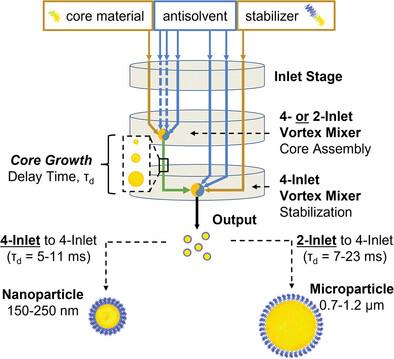Design of Modular, 3D‐Printed Millifluidic Mixers to Enable Sequential NanoPrecipitation (SNaP) for the Tunable Synthesis of Drug‐Loaded Nanoparticles and Microparticles
引用次数: 0
Abstract
Sequential NanoPrecipitation (SNaP) is a nascent controlled precipitation process for the tunable formation of polymeric particles for drug delivery and bioimaging. While SNaP utilizes the same self‐assembly principles as one‐step Flash NanoPrecipitation, SNaP is a two‐step assembly process in which the particle core formation is initiated during a first mixing step followed by particle stabilization in a second mixing step. Current SNaP experimental set‐ups use commercial millifluidic mixers connected in series, which have several limitations, including the inability to access short inter‐mixer delay times (Td). A robust, 3D‐printed, modular mixer design that enables access to short Td's (〈 25 ms) not previously accessible is reported. For the first time, it is demonstrated that decoupling the assembly steps improves control over particle size, expanding the attainable size range to include both nanoparticles and microparticles. It is empirically proven that inter‐mixer Td is a key parameter for particle size control and that particle size scales with Td in agreement with Smoluchowski's model of diffusion‐limited growth. The formation of particles ranging in size from 160 nm to 1.2 µm is shown. Finally, the applicability of the new mixers is established by encapsulating fluorophores and therapeutics into particles for the first time via SNaP.

设计模块化三维打印毫流体混合器,实现顺序纳米沉淀(SNaP),以可调方式合成载药纳米颗粒和微颗粒
顺序纳米沉淀(SNaP)是一种新兴的可控沉淀工艺,用于形成可调的聚合物颗粒,用于药物输送和生物成像。虽然 SNaP 采用的自组装原理与一步闪速纳米沉淀相同,但 SNaP 是一个两步组装过程,其中颗粒核心的形成在第一步混合过程中启动,然后在第二步混合过程中稳定颗粒。目前的 SNaP 实验装置使用串联的商用毫流体混合器,这种混合器有一些局限性,包括无法获得较短的混合器间延迟时间(Td)。本报告介绍了一种坚固耐用的三维打印模块化混合器设计,它可以实现以前无法实现的短Td(〈 25 ms)。研究首次证明,将组装步骤解耦可以改善对粒度的控制,从而将可实现的粒度范围扩大到纳米颗粒和微颗粒。经验证明,混合器之间的 Td 是控制颗粒大小的关键参数,颗粒大小与 Td 成比例,与 Smoluchowski 的扩散受限生长模型一致。结果表明,形成的颗粒大小从 160 纳米到 1.2 微米不等。最后,通过 SNaP 首次将荧光团和治疗药物封装到颗粒中,证明了新型混合器的适用性。
本文章由计算机程序翻译,如有差异,请以英文原文为准。
求助全文
约1分钟内获得全文
求助全文

 求助内容:
求助内容: 应助结果提醒方式:
应助结果提醒方式:


